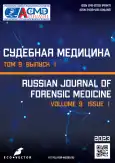Cavernous sinus thrombosis as a cause of fatal outcomes in forensic medical practice
- Authors: Muzikin M.I.1,2,3, Ilyasov D.M.2, Iordanishvili A.K.2, Barinov E.K.4
-
Affiliations:
- Saint-Petersburg Medico-Social Institute
- Kirov Military Medical Academy
- Our news: Saint-Petersburg Research Institute of Ear, Throat, Nose and Speech
- Moscow State University of Medicine and Dentistry named after A.I. Evdokimov
- Issue: Vol 9, No 1 (2023)
- Pages: 57-68
- Section: Case reports
- URL: https://journal-vniispk.ru/2411-8729/article/view/133085
- DOI: https://doi.org/10.17816/fm765
- ID: 133085
Cite item
Full Text
Abstract
Cavernous sinus thrombosis is a life-threatening condition resulting from a blockage of the cavernous sinus by a blood clot. This pathology occurs extremely rarely but is a danger to life at any age. Information about deaths from cavernous sinus thrombosis is limited and unclear in the special forensic medical literature.
This study analyzed the results of the forensic medical examination of the corpse of a 35-year-old woman. This work outlines all stages of treatment and observation of the patient. Disease development and progression, which eventually led to a fatal outcome, were described in stages.
The research and results were able to confirm the cause of death. Cavernous sinus thrombosis and other cerebral sinus thrombosis, as a complication of the main, timely undiagnosed, and untreated disease, is a significant problem even in modern multidisciplinary medical institutions and often causes deaths in clinical practice.
Full Text
##article.viewOnOriginalSite##About the authors
Maxim I. Muzikin
Saint-Petersburg Medico-Social Institute; Kirov Military Medical Academy; Our news: Saint-Petersburg Research Institute of Ear, Throat, Nose and Speech
Author for correspondence.
Email: MuzikinM@gmail.com
ORCID iD: 0000-0003-1941-7909
SPIN-code: 7169-1489
MD, Dr. Sci. (Med.), Associate Professor
Russian Federation, Saint Petersburg; Saint Petersburg; Saint PetersburgDenis M. Ilyasov
Kirov Military Medical Academy
Email: SPB118@yandex.ru
ORCID iD: 0000-0002-3809-2903
SPIN-code: 9664-3215
MD, Cand. Sci (Med.)
Russian Federation, Saint PetersburgAndrey K. Iordanishvili
Kirov Military Medical Academy
Email: Professoraki@mail.ru
ORCID iD: 0000-0003-0052-3277
SPIN-code: 6752-6698
MD, Dr. Sci. (Med.), Professor
Russian Federation, Saint PetersburgEvgeny K. Barinov
Moscow State University of Medicine and Dentistry named after A.I. Evdokimov
Email: ev.barinov@mail.ru
ORCID iD: 0000-0003-4236-4219
SPIN-code: 2112-4568
MD, Dr. Sci. (Med.), Professor
Russian Federation, MoscowReferences
- Khaydarova FA, Alieva AV, Kamalov TT, Talenova VA. Condition after thrombosis of the cavernous sinus complicated by osteomyelitis of the upper jaw after a coronavirus infection in a patient with type 2 diabetes mellitus. Juvenis Scientia. 2021;7(3):28–35. (In Russ). doi: 10.32415/jscientia_2021_7_3_28-35
- Berest IE, Mironets SN. Septic thrombosis of the cavernous sinus. Bulletin of otorhinolaryngology. 2017;82(6):72–76. (In Russ). doi: 10.17116/otorino201782672-76
- DiNubile MJ. Septic thrombosis of the cavernous sinuses. Arch Neurol. 1988;45(5):567–572. doi: 10.1001/archneur.1988.0052029010302
- Idiculla PS, Gurala D, Palanisamy M, et al. Cerebral venous thrombosis: A comprehensive review. Eur Neurol. 2020;83(4):369–379. doi: 10.1159/000509802
- Krasnozhen VN, Andreeva IG. Petrositis complicated by cavernous sinus thrombosis, meningitis. Bulletin Otorhinolaryngology. 2015;80(4):44–46. (In Russ).
- Iordanishvili AK, Tolmachev IA, Muzikin MI, et al. Professional errors and defects in the provision of medical care in the dental rehabilitation of adult patients. Bulletin Military Med Academy. 2016;1(53):50–55. (In Russ).
- Karshiev HK, Robustova TG, Muzykin MI, Iordanishvili AK. Evaluation of the severity of the course of complicated forms of acute odontogenic infection. Bulletin Russian Military Med Academy. 2017;(4):67–71. (In Russ).
- Verezgov VA, Breusenko DV, Pavlov PV, et al. Transnasal surgery for intracranial rhinogenic complications in children. Analysis of two clinical cases. Pediatrician. 2022;13(1):69–81. (In Russ). doi: 10.17816/PED13169-81
- Poel NA, Mourits MP, Win MM, et al. Prognosis of septic cavernous sinus thrombosis remarkably improved: A case series of 12 patients and literature review. Eur Arch Otorhinolaryngol. 2018;275(9):2387–2395. doi: 10.1007/s00405-018-5062-9
- Plewa MC, Tadi P, Gupta M. Cavernous Sinus Thrombosis. In: StatPearls. Treasure Island (FL): StatPearls Publishing; 2022.
- Tagirova ZG, Ponezheva ZhB, Makashova VV, Magomedova SA. Septic thrombosis of the cavernous sinus in a patient with COVID-19 (Case report). In: Materials of the II Internet Conference on Infectious Diseases “Pokrovsky Readings”, November 1-3, 2022: Collection of abstracts. Moscow: Medical Marketing Agency; 2022. Р. 46. (In Russ).
- Selvadurai S, Virk JS. Cavernous sinus thrombosis secondary to sphenoid mycetoma following COVID-19 infection. QJM. 2021;114(8):594–595. doi: 10.1093/qjmed/hcab075
- Oripov OI, Bilalov EN. Cavernous sinus thrombosis associated with COVID-19. J Ophthalmology. 2021;(2):69–71. (In Russ). doi: 10.31288/oftalmolzh202126971
- Mokgacha K, Maruza MP, Sesay SO, Rwegerera GM. Cavernous sinus thrombosis in a 14-year old boy. Turk J Pediatr. 2017;59(6):719–723. doi: 10.24953/turkjped.2017.06.019
Supplementary files














